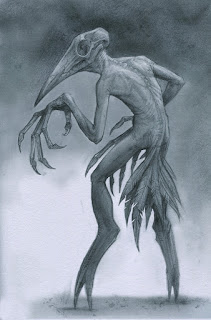But some of the Forms were disharmonious. They ruined the landscape, incited men to sin, or made unpleasant noises. The serpicant was one such disharmonious beast--it was simply overly good at catching and killing humans, the favored creations of the Authority.
And so the serpicants thrived while the humans dwindled. And since the serpicant was pleasing to the Authority in its own way, he did not destroy it, but instead separated it into three animals: the elephants, the lion, and the serpent.
That is why lions, elephants, and snakes have been mortal enemies, each sensing their own incompleteness mirrored in the other.
 |
| by herbert dicksee a man who specialized in drawing deerhounds |
"What heaven cleaves," said Kadoom the Ur-Wizard, "I can join."
Kadoom was incandescent in his ambition. No wizard before or since has ever shown more alacrity towards abomination, nor talent for it.
The recreation of the Serpicant was the first blasphemy that saw Kadoom driven from his kingship and into exile. Despite being suppressed by the church, the process of their creation is common knowledge among wizards.
It is said that it involves the marriage of a viper and an lioness inside the slit belly of a living elephant. Since no priest of the Church will ever preside over such an act, it must be performed by a demon of appropriate rank. In the consummation of that marriage the viper is consumed entirely--being too small to serve as a proper husband, the serpent functions as his seminal issue, and disappears into the lioness' tissues.
Four months later, the lioness will lay a single black egg. She must be separated from it immediately, since she will instinctively destroy it if given a chance.
The actual incubation requires a witch and a black hen, who take turns incubating the egg.
(This is the actual method to make a serpicant. It's not hard to do at all (compared to some of the shit that golem manuals require). It's a ritual that isn't abstracted. If the PCs ever find themselves with possession of a captive lioness, you might mention (remind the wizard) that they just need to get a demon to conduct a wedding.)
Biology
Weasels, snakes, and daschunds all share a similar bodyplan. Narrow, sleek, and compact. They're meant to fit into small places, where they will kill animals smaller than them.
They have short, powerful legs, good for pushing but not for jumping. They have powerful jaws and strong necks, that they use to crush and shake their prey.
Digression: I remember playing WoW and fighting dragons. Their attack animation was often just a little claw swipe, like they were reaching out to pick up a beer. Or a single dainty bite. It's very different from how predators actually catch and kill smaller prey. Crocodiles, dogs, lions: they bite it across the back or neck, they pick it up, and then they shake the shit out of it.
If it wasn't circle-strafing and breathing fire, that's how a dragon would kill you. It's like being in a car crash that keeps repeating.
Usage
There is a niche for intelligent, persistant, and cruel enemies. Ones that are tactically brilliant and infuriatingly proactive. (The opposite of 3 orcs who just sits in a room waiting to be killed, although those orcs have their place, too.)
Remember in Jurassic World, when all the mercenary dudes realized that they were fighting a cagey, clever mini-Godzilla? That's what you're going for.
Keep them clever. A single serpicant will use it's poison cloud to drive it's prey into disadvantageous locations. In a dungeon, they may even try to drive the party into other rooms, where other monsters can attack them.
"Go kill the serpicant that lives inside the wooden palace." is a good quest, but it gets better when there turns out to be two of them.
Serpicant
HD 6 AC chain Bite 2d6+grab
Move 15 Climb 9 Int* 15 Str 18 Mor 7
Immune to Poison.
Opportunist - Deals +2d6 damage when attacking with situational advantage (surprise, prone, held enemy, blind enemy).
Spit Poison- Usable 3/day. 50' range. Spits a glob of noxious poison. On a direct hit, treat like acid arrow except that it is poison damage. Regardless of what it hits, though, the poison quickly forms a toxic yellow fog that fills the air within 30'. This fog blocks vision beyond 10' and deals 1 damage per round to every creature in the fog. Anyone who opens their eyes within the fog must make an easy (+4) Con check each round or go blind for 1d4 days (where 4 = permanent). Without a strong wind, the fog will last for 1 minute.
Remember that the purpose of Spit Poison is to kite the party through the dungeon, or to force the party to kite the serpicant.
Tactics
- Never engage in a fair fight. Engineer traps. Kill one, then retreat. Use the environment to your advantage (leverage that Opportunist ability).
- Use your poison cloud to drive enemies out of defensible positions, and to create advantageous environments. Maybe just spit poison and then run away in the confusion, returning 10 minutes later.
- Kill them one at a time. Bite an enemy, hold on to them, and then just shake them until they are dead (Opportunist).
Treasure
- A nest will have 1d2 eggs, each worth 1000g.
- In the hands of an alchemist, serpicant blood can be used to enhance all manner of poisons. But anyone can render the blood down into 3d6 Antidote potions.
- Adamantine collar inscribed with wizarding insignia, with 3' of adamantine chain.
- Pearl-covered serpicant saddle. Worked leather, dyed crimson. Pommel hides a poisoned punch dagger. All worth 1500g.




